10 TIPS TO BREAK THROUGH A BENCH PRESS PLATEAU
Out of all the various weight training exercises that lifters tend to get “stuck” on, the basic barbell bench press is definitely one of the most common.
Everyone in the gym wants a big bench, but even the most serious of trainees can hit a rut every now and then.
Fortunately, a few simple changes are usually all that’s needed to reverse the pattern and keep the strength gains coming.
So, if you’ve hit a bench press plateau and can’t seem to add more weight to the bar despite all your effort, here are 10 simple but effective tips that should take care of the problem…
#1 – Have Realistic Expectations
The first question to ask yourself here is whether or not you’ve actually hit a legitimate bench press plateau to begin with.
Just like building muscle is a slow and gradual process that requires time and patience, so is building a big bench press.
Often times someone will come to me claiming that their “bench press is stuck,” when in reality they’re progressing at a perfectly reasonable pace and are just expecting too much too soon.
For example, if all you did was add 5 pounds to the bar for every 3 weeks of consistent benching (that’s 1.7 pounds per week on average), that would add up to 85 pounds gained over the course of a year.
Certainly nothing to sneeze at for the year as a whole, yet the individual improvements from week to week would be so small that it might feel as though they hardly even count.
If you want to add a significant amount of weight to your barbell bench press, you have to focus on baby steps and recognize that even 1 extra rep with the same weight is still significant progress and in no way means you’ve hit a plateau.
Start writing down your workouts in detail by making clear records of the weight you lifted along with the exact sets and reps for each session, and then put all of your focus on “beating the logbook” with small micro progressions from week to week. (Also known as progressive overload.)
Aim for an extra rep or two with the same weight, and once you’ve hit the upper end of your prescribed rep range, add 5 pounds to the bar and train for reps again.
As long as the numbers are consistently moving upward over time, you’re probably on the right track and may not need to make any adjustments at all.
#2 – Prioritize The Bench Press

Research has shown that whatever you train first in your workout will improve the fastest, both in terms of strength and muscle growth. (1, 2)
This is because you’ll be hitting that particular exercise (or muscle group) when your muscles and nervous system are fresh and when you’re the most physically and mentally primed.
So, if your other lifts seem to be improving but your bench press isn’t, make sure to prioritize the bench by performing it as the very first movement in your workout.
#3 – Hone Your Technique
The barbell bench press may look very simple on the surface, but it’s actually a very technically complex movement involving many small nuances that must be taken into account if you want to put up the biggest numbers possible.
In many cases, fixing your bench press plateau is a matter of fixing your bench press technique.
Just like any other exercise in the gym, the bench press is a skill that can be learned and improved on with the proper knowledge and experience.
While entire books have been written on the subject of correct bench press form, here are a few of the more important points to keep in mind…
1) Retract your scapula and keep your elbows slightly tucked. This allows you to drive your shoulders back into the bench as you press the weight up for greater strength numbers and improved safety on the shoulder joints.

2) Keep your legs under tension throughout the movement. You can do this by placing your feet underneath your knees, driving your heels into the ground, and forcing your knees out.

3) “Pull the bar apart” as you lower it. This enhances the activation of your upper back and rear delt muscles and aids with shoulder stability.
4) Keep your wrists in a neutral position. Many lifters allow their wrists to bend backward as they bench which decreases strength output and places stress on the wrist joints. When you grab onto the bar, position it on the lower “meaty” portion of your palm rather than higher up towards your fingers. This decreases the leverage on your wrists, thereby making it easier to maintain a neutral position and preventing the chances of developing unwanted bench press wrist pain.
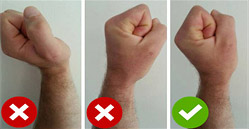
5) Use the proper grip width. Since everyone’s body structure is a bit different, there is no single grip width that will apply to every lifter across the board. The bottom line though is to find the width that causes your forearms to be perpendicular to the floor with your hands and elbows directly stacked on top of each other as seen below.
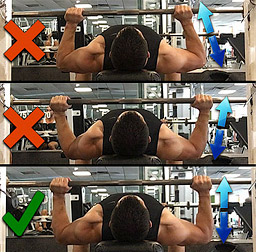
6) Explode on the way up. When you lift a weight with maximal force, you increase muscle fiber recruitment for faster strength gains. One study that matched training volume and intensity found lifters who did each concentric rep with maximum speed gained approximately twice the strength after 6 weeks. (3)
#4 – Increase Your Bench Press Volume

If you want to get better at math, you have to do more math.
If you want to get better at the guitar, you have to play more guitar.
While there certainly can come a point of doing too much, the same basic logic applies to gaining strength on a given movement.
If you’ve been stuck in a bench press plateau that just won’t seem to budge, one of the simplest solutions is to just bench press more often.
This will help not only in terms of increasing your raw physical strength, but also in terms of becoming a better bench presser from a technical standpoint.
So, if you’re currently bench pressing just once per week, try increasing that to twice per week. If you’re already benching twice per week, increase that to 3 times per week.
Along with the increase in benching frequency, you can also optionally increase your volume per session as well.
If your workouts currently call for 3 sets of bench presses in total, kick that up to 4 or 5 sets.
Keep in mind though that if you are going to be doing a higher volume bench pressing phase, you’ll want to decrease the volume a bit on your other exercises to compensate.
Your body only has a limited capacity for recovery, and doing too much overall work could potentially have the opposite effect if you aren’t careful.
#5 – Perform Accessory Movements
Remember that the bench press is a compound movement, and although the pecs are the primary targeted muscle, your shoulders and triceps are heavily involved as well.
A chain is only as strong as its weakest link, and all of these muscle groups need to be fully strengthened in order to continually add more weight to your bench.
A very simple way of determining where your possible weak points are is to examine your sticking point, or the point in the bench press where you usually miss the lift.
As a general rule, if your sticking point is during the bottom half of the movement, you’ll want to strengthen your pecs or shoulders, or both.
A few good options for this include…
Dumbbell Press: A basic flat or incline dumbbell press allows for a slightly larger range of motion to help you strengthen that bottom position further.

Paused Bench Press: This is the same as a normal bench press except that you’ll hold the bar in place for a 2-3 second count once it touches your chest before pressing it back up again.
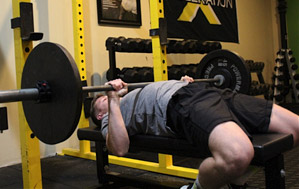
Overhead Press: Adding poundage to your overhead barbell or dumbbell press will also be helpful since the additional shoulder strength you develop will directly carry over to your horizontal presses as well.
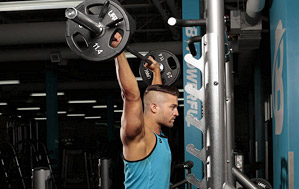
On the other hand, if you tend to miss the lift during the upper half of the bench press, it’s your triceps that need some more work.
In this case you’ll benefit from the following lifts:
Close-Grip Bench Press: The same as a normal bench press except with your hands spaced shoulder-width apart. This will shift more emphases onto the triceps as opposed to the pecs.
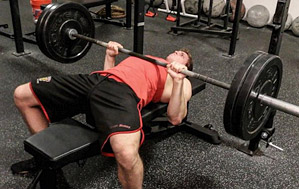
Board Press or Pin Press: Having a training partner stack a board or two on top of your chest will shorten the range of motion to help you specifically work on that upper lockout position.
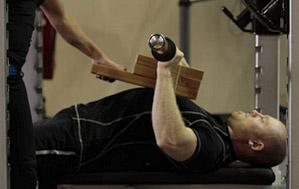
The other option (and probably the easier one) that will produce the same effect is to simply bench press inside of a power rack with the pins placed higher up.
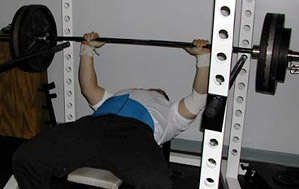
Tricep Extensions: Any basic tricep isolation movement such as a pushdown, skull crusher or overhead extension can also be used to further build and strengthen your triceps for improved bench pressing strength.

#6 – Increase Your Calories

If you find that several of your lifts have hit a sticking point besides just the bench press and you haven’t been gaining any body weight in the recent weeks and months, simply bumping up your calories will often do the trick.
While you can build considerable strength while eating at maintenance calories (or even in a deficit if you’re a beginner), this will usually only happen up to a certain point before adding more overall mass to your frame becomes a necessity for further strength gains.
This is especially true when it comes to a bench press plateau where having a higher overall body weight will give you more leverage and control over the weight during the lift.
In fact, when most lifters implement a cutting phase and begin dropping body weight, the bench press is usually one of the very first lifts where strength losses become clearly noticeable.
#7 – Perform A Weight Acclimation Warmup
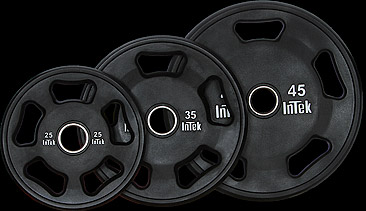
Aside from the use of a general pre-workout warmup using techniques such as mobility work, stretches and self-myofascial release (check out my step-by-step upper body warmup for more info on that), a weight acclimation warmup can help to prime your muscles and nervous system for optimal strength output prior to your working sets on a given exercise.
The basic idea here is to start off with a very light weight for higher reps, and then gradually increase the weight while lowering the reps and working up to the maximum weight you’ll be using for your first main set of the workout.
The numbers don’t need to be exact, but here’s a basic template you can follow for this…
Set #1: 40% x 8 reps
Set #2: 55% x 5 reps
Set #3: 70% x 3 reps
Set #4: 85% x 2 reps
Set #5: 100% x 1 rep
So, if you were planning to bench press 200 pounds for your first working set, you’d warmup with 80 x 8, 110 x 5, 140 x 3, 170 x 2, 200 x 1, and then move into your working sets.
These warmups should not fatigue you in any way or compromise your strength for the heavy sets ahead, so make sure to take things slowly and ease up if you find yourself feeling tired.
#8 – Decrease Your Rep Range
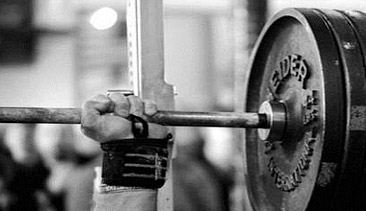
If you’ve been performing the majority of your bench press sets in moderate to higher rep ranges of 8 or more, try increasing the weight slightly and dropping your reps down to the 4-6 range instead.
Heavier weights for lower reps will be more effective for building raw strength (and are still highly effective for stimulating muscle growth as well) and may be exactly what you need to generate further improvements and break out of your bench press plateau.
These types of sets will limit lactic acid production and reduce the buildup of the pump, allowing you to place 100% of your focus on simply moving as much weight as possible on each set.
Just make sure to increase the weight cautiously and ensure that your form and technique are still 100% on point despite the heavier load.
#9 – Rest Longer In Between Sets

As I’ve outlined in previous articles, if your goal is to build muscle and gain strength at your full capacity, proper rest time in between sets is critical.
This is especially true in the case of a bench press plateau where generating every bit of strength possible is critical in helping you add more weight to the bar.
The last thing you want to be doing is jumping right into your next set before you’ve had a chance to fully recover both physically and mentally from the previous one.
Shorter resting times of 1-2 minutes may be fine for those lighter and less demanding isolation exercises, but if your bench has hit a sticking point, try bumping up the rest periods to at least 3-4 minutes between each set.
This will give you a chance to fully reset and ensure that your strength isn’t being compromised before getting back under the bar.
#10 – Use Microplates
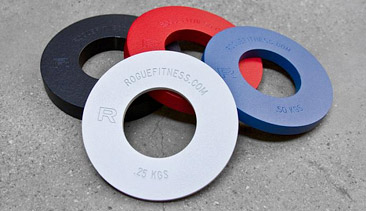
Let’s say your bench has been stuck at 200 pounds for 5 reps for a few weeks. You can’t seem to squeeze out that 6th rep, but increasing the weight to 205 feels too heavy for you.
One option in a case like this is to “microload” your bench press by adding 1.25 pound plates (or even less) to each side of the bar instead of the regular 2.5’s.
There’s nothing particularly special or mandatory about increasing your bench by exact 5 pound increments at a time, and sometimes adding a bit less than that can help you land in the “sweet spot” needed to keep things moving.
You can purchase microplates from Amazon or your local gym equipment store and then just keep them in your gym bag for when you need them.
If you found these bench press tips helpful, make sure to get your personalized training, nutrition and supplement plans using my free interactive video presentation below…
If you found this article helpful, make sure to sign up for your FREE custom fitness plan below...




